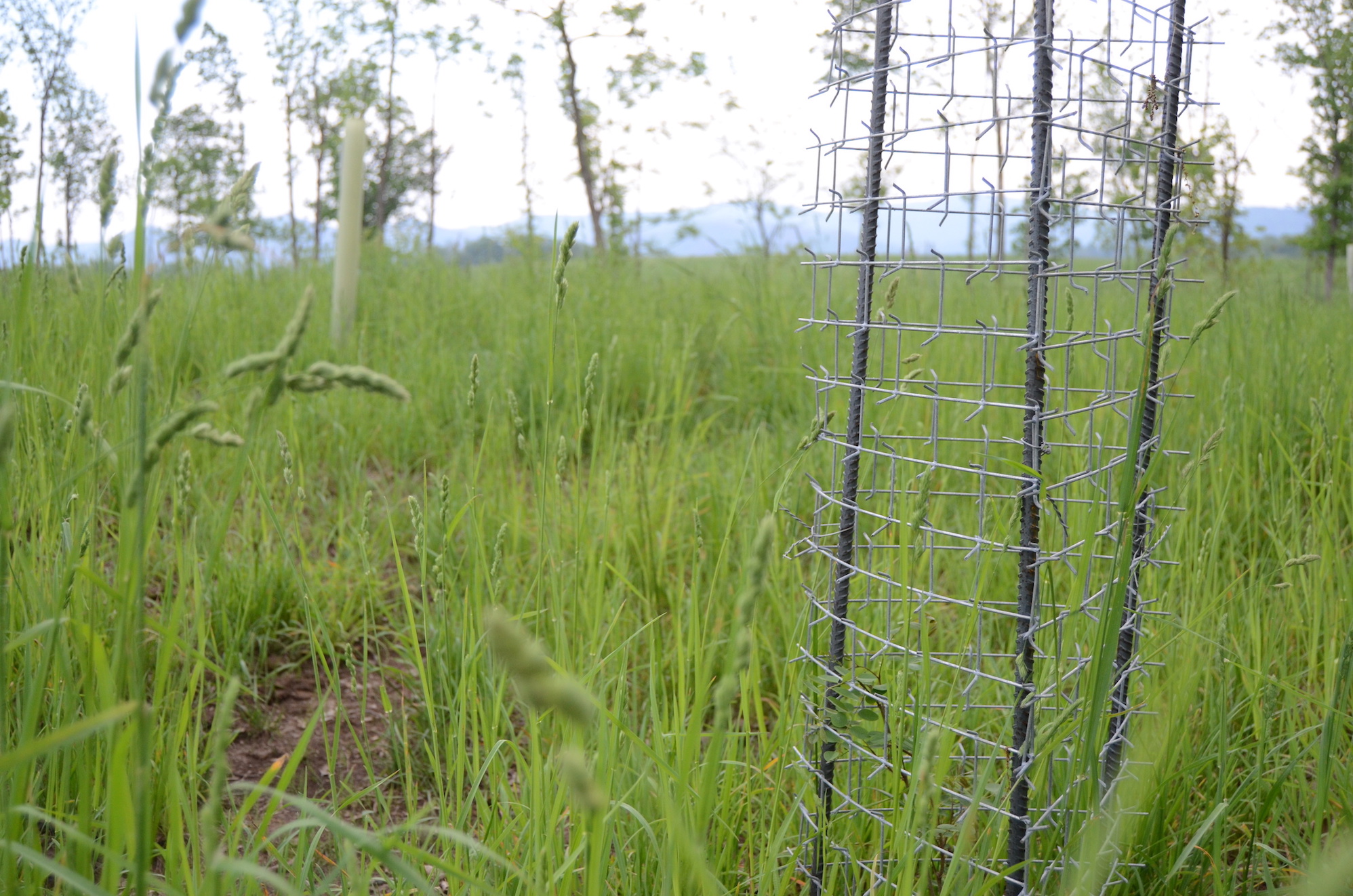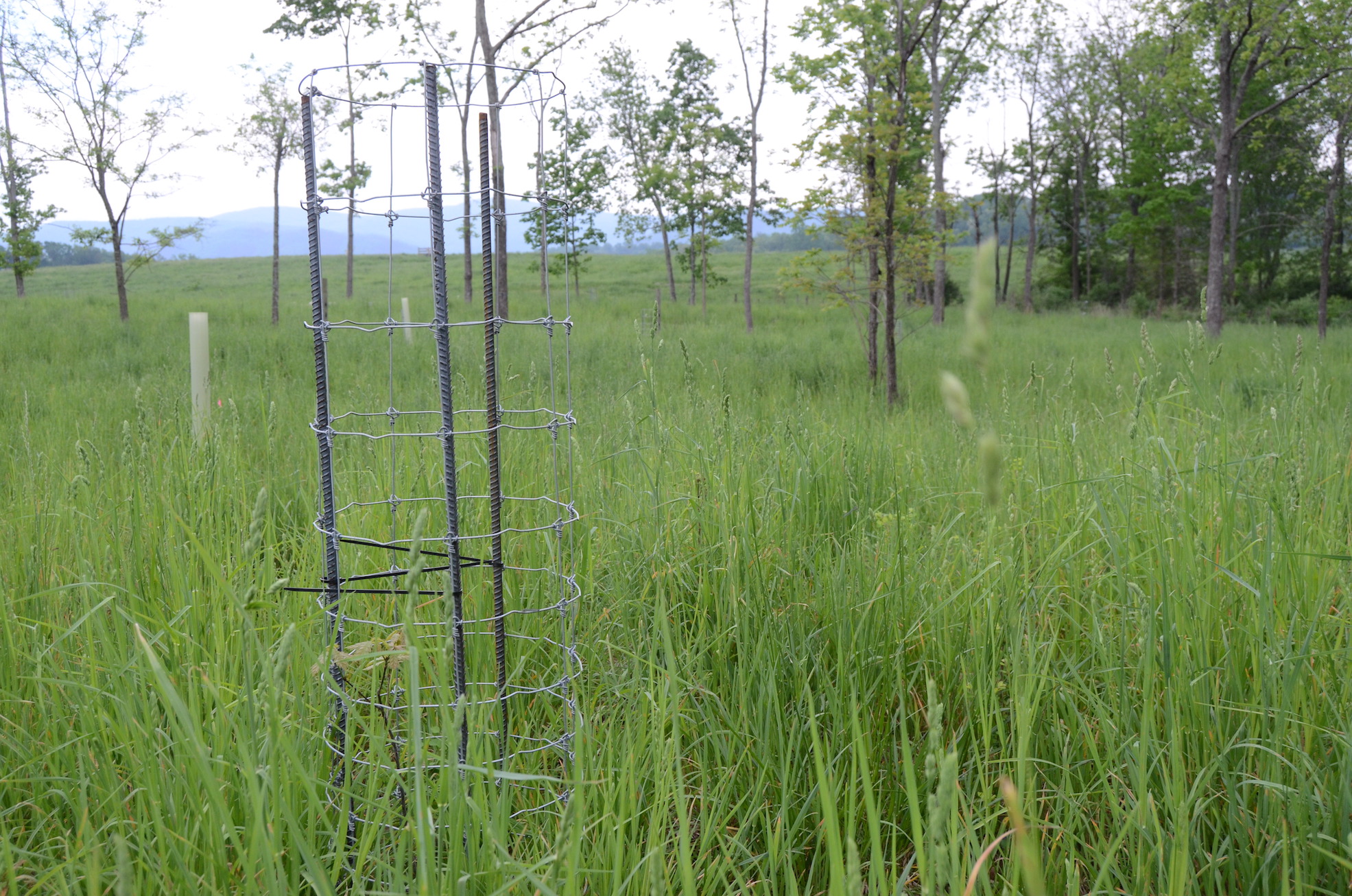The removal of livestock from a pasture during the tree establishment phase may not be a requirement for the successful integration of trees into a pasture. While a multitude of factors influence tree survival, field-trial research projects at Virginia Tech’s Shenandoah Valley Agricultural Research and Extension Center suggests that newly-planted trees can be protected from livestock that would otherwise destroy them.
A demonstration silvopasture project on this farm aims to show how a degraded hardwood stand on a medium quality site might be converted into a mixed-use forage, livestock and timber-producing system. In this case, the silvopasture was developed by thinning an unmanaged timber stand full of invasive species (primarily bush honeysuckle (Lonicera spp.)). Green ash (Fraxinus pennsylvanica) was the dominant tree species in the stand. Unfortunately, the emerald ash borer found and decimated these trees, and they had to be removed, leaving the resulting silvopasture with too few trees.
Figure 1 Arborshield tree guide used to protect a black locust tree
To increase the number of trees back to a suitable density, we planted seedlings of three species - black locust (Robinia pseudoacacia), red oak (Quercus rubra), and shortleaf pine (Pinus echinata). We also tested four methods for protecting the new seedlings from cattle currently using the site. These included: an Arborshield tree guard (Figure 1), a homemade tree cage (like a tomato cage) made from fixed-knot fence (Figure 2), a conventional tree tube, and no protection. Arborshield tree protectors are designed with barbs to keep livestock and large wildlife (such as deer) away from the trees. Including the rebar and zip ties, each fixed-knot cage cost $8.30 and each Arborshield cage cost $24.68.
Each of the four protection treatments was tested on three red oaks and three black locusts within each of the site’s four paddocks. For the shortleaf pine, only the Arborshield and “do nothing” treatments were tested. The trees and treatments were established in the spring of 2018, with help from the Department of Forestry. The Department of Forestry also donated the trees and Conservation Services donated tree tubes. Calves (average weight = 500 lb) were rotationally stocked through these pastures throughout the summer. The trees and the treatments were assessed in the fall of 2018. We checked each tree to see whether it was alive or dead (or couldn’t be found, which not surprisingly was the case for many of the “do nothing” trees). We also evaluated the protection treatments for functionality or damage due to the cattle. Finally, we looked at each tree for browse damage from the livestock or wildlife. These results are summarized in Table 1. (Many of the shortleaf pine did not survive or could not be found, so these are not included.)
Figure 2 Homemade tree cage constructed from fixed-knot fence used to protect a red oak tree
Table 1 Tree counts and evaluation of protection methods and browse damage
|
Black locust |
Status |
Protection |
Browse damage |
|||
|
Treatment |
Alive |
Missing/Dead |
Functional |
Damaged/missing |
Evident |
None |
|
No protection |
1 |
11 |
. |
. |
12 |
0 |
|
Tree tube |
8 |
4 |
4 |
8 |
10 |
2 |
|
Fixed-knot cage |
12 |
0 |
12 |
0 |
8 |
4 |
|
Arborshield |
11 |
1 |
12 |
0 |
11 |
1 |
|
Red oak |
Status |
Protection |
Browse damage |
|||
|
Treatment |
Alive |
Missing/Dead |
Functional |
Damaged/missing |
Evident |
None |
|
No protection |
6 |
6 |
. |
. |
8 |
4 |
|
Tree tube |
10 |
2 |
6 |
6 |
4 |
8 |
|
Fixed-knot cage |
12 |
0 |
12 |
0 |
1 |
11 |
|
Arborshield |
11 |
1 |
12 |
0 |
2 |
10 |
As logic would suggest, the data support that “doing nothing” after planting a tree in a pasture is unlikely to result in an established tree. Most of the black locusts and half of the red oaks without any protection were missing or dead. Perhaps also not surprisingly, the tree tubes were not an effective means of protecting trees. One-third of the black locust trees protected with a tube were missing or dead and only one-third of the tubes were still intact. The red oaks in tree tubes did not sustain as much damage as the black locusts, perhaps because their foliage is not as preferred a browse by livestock. Both the Arborshield and the “tomato cage” protected these young trees from livestock and withstood any trampling or rubbing by the cattle. In terms of browse, the black locust were more preferred by livestock or wildlife. It will be important to track these protectors over time as the trees begin to grow out of the top of the cages.
As riparian buffers are fenced out and fencelines are cleaned up, many producers are finding themselves without sufficient shade in their pastures for livestock. In some cases, this might mean that they must construct or purchase expensive shade structures that will depreciate over time. For other producers, strategically planting trees might be the best long-term solution. Shade will not come instantaneously, but our work to date suggests that with fairly simple inputs and rotational stocking management, pastures can be kept in production while the trees are being established.


